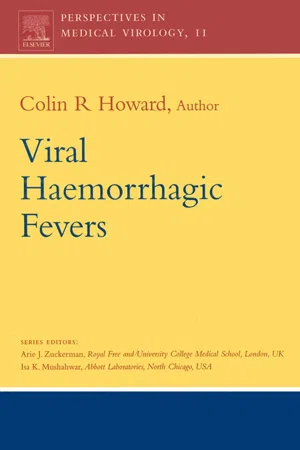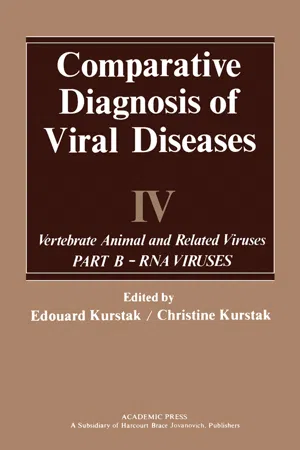Biological Sciences
Arenavirus
Arenaviruses are a family of viruses that can cause severe illnesses in humans, including hemorrhagic fevers. They are typically transmitted to humans through contact with infected rodents or their excretions. The viruses are named after the sand-like appearance of their ribonucleic acid (RNA) under electron microscopy. Notable examples of arenaviruses include Lassa virus and Junin virus.
Written by Perlego with AI-assistance
Related key terms
1 of 5
11 Key excerpts on "Arenavirus"
- eBook - PDF
Mucocutaneous Manifestations of Viral Diseases
An Illustrated Guide to Diagnosis and Management
- Stephen Tyring, Angela Yen Moore, Omar Lupi, Stephen Tyring, Angela Yen Moore, Omar Lupi(Authors)
- 2016(Publication Date)
- CRC Press(Publisher)
Each virus is usually associated with a particular rodent host spe- cies in which it is maintained. Arenavirus infections are relatively common in humans in some areas of the world and can cause severe illnesses. The family Arenaviridae consists of a unique genus (Arena- virus) that currently contains 24 recognized viral species [1,2], of which five can cause viral hemorrhagic fevers, with a case fatality rate of about 20% (Table 20.1). The virus particles are spherical and have an average diameter of 110–130 nm. All are enveloped in a lipid membrane. Viewed in cross section, they show grainy particles that are ribosomes acquired from their host cells. It is this characteristic that gave them their name, derived from the Latin “arena,” which means “sandy.” Their genome is composed of single-stranded, bi- segmented RNA, and while their replication strategy is not com- pletely understood, we know that new viral particles, i.e., virions, are created by budding from the surface of their hosts’ cells [2–4]. According to their antigenic properties, the Arenaviruses are clas- sified into two groups: the New World or Tacaribe complex, which includes viruses indigenous to the Americas, and the Old World or Lassa/lymphocytic choriomeningitis (LCM) complex, which includes viruses indigenous to Africa and the ubiquitous LCM virus (LCMV) that is associated with Mus musculus (Fig. 20.1). These viruses are zoonotic, meaning that, in nature, they are found in animals. Each virus is associated with either one species or a few closely related rodents, which constitute the virus’ natural reservoir. Tacaribe complex viruses are generally associated with the New World rats and mice belonging to the family Cricetidae, subfamily Sigmo- dontinae (Figures 2 and 3). The Lassa/LCM complex viruses are asso- ciated with the Old World rats and mice (family Muridae, subfamily Murinae). - Dongyou Liu(Author)
- 2014(Publication Date)
- CRC Press(Publisher)
9 2 2.1 INTRODUCTION Classified in the Arenaviridae family Arenaviruses naturally and chronically infect rodents, which serve as a reservoir host and carry the virus in an asymptomatic manner. Rodent species appear to be specifically and chronically infected by a virus species and represent a model of virus–host coevolu-tion (Table 2.1). 1 One exception is the Tacaribe virus (TACV), an Arenavirus that has been found naturally and specifically infecting chiropterans; however, a recent work raised doubts about the classically identified bat reservoir. 2,3 Recently a virus has been isolated from reptiles (Boinae subfamily), and identi-fied as an Arenavirus; if it is confirmed as a new Arenavirus spe-cies, it will reveal additional insight into the Arenavirus family, in relation to its potential to adapt from one host to another, to coevolve, and to pose zoonotic risk in other host species. 4 Several Arenaviruses are known to infect humans acci-dentally and cause a range of zoonotic diseases, from mild to severe illness and, eventually, death. Although the arena-virus prototype species, the Lymphocytic Choriomeningitis Virus (LCMV) of mice, is responsible for a neurological syn-drome in humans, viral hemorrhagic fever (VHF) represents the main Arenavirus-associated severe syndrome in humans. Bleeding tendencies are often recorded but not always life threatening, with a mortality rate of 30% during epidem-ics. Nonhuman primates can be infected experimentally, but there is no evidence that these viruses are pathogenic for domestic animals (e.g., livestock, cats, and dogs), although exotic pets (hamster, mice, etc.) represent a potential source of infection, in particular for the LCMV. 5,6 The Arenaviridae family consists to date of a unique Arenavirus genus including 24 recognized virus species (Table 2.1) and two pending species not yet registered. 7 Among the 24 Arenavirus species, 7 are highly pathogenic for humans and responsible for causing hemorrhagic fever.- eBook - ePub
- Douglas D. Richman, Richard J. Whitley, Frederick G. Hayden, Douglas D. Richman, Richard J. Whitley, Frederick G. Hayden(Authors)
- 2016(Publication Date)
- ASM Press(Publisher)
FIGURE 2 Geographic distribution of New World Arenaviruses. Above: The virus name and known or suspected rodent reservoir are listed, with viruses associated with natural infection and disease in humans in bold. Although the virus has been isolated from the animal listed, the status of that animal as the natural reservoir is not established in all cases. Countries with Arenaviruses definitively associated with human disease are shaded gray. The distribution of the virus and incidence of associated disease may vary significantly within each country. Many of the New World Arenaviruses have been isolated on single or very few occasions and the precise distribution of the virus beyond the place of first identification is unknown. Below: Closeup of administrative regions in which Venezuelan, Bolivian, Chapare, and Argentine hemorrhagic fever have been recognized. The distribution of the viruses and incidence of disease may vary significantly within the region.Arenaviruses are perhaps best known as agents of viral hemorrhagic fever (VHF), an acute systemic illness classically involving fever, a constellation of initially nonspecific systemic signs and symptoms, and a propensity for causing bleeding and shock (11 , 12 ). Similar VHF syndromes are caused by members of the virus families Bunyaviridae , Filoviridae , and Flaviviridae (see chapters 9 , 42 , 44 , and 53 ). A few Arenaviruses have been associated with aseptic meningitis and other central nervous system (CNS) diseases, including congenital malformations when transmitted in utero . Many Arenavirus infections are asymptomatic or result in a nonspecific febrile illness difficult to distinguish from many more common diseases.Seven Arenaviruses have been clearly established as causative agents of VHF via natural infection (i.e., excluding laboratory infections): Lassa and Lujo in Africa, and Junín, Machupo, Guanarito, Sabiá, and Chapare in South America (Table 1 ). Two Old World Arenaviruses, lymphocytic choriomeningitis virus (LCMV) and an LCMV variant named Dandenong virus, are typically associated not with VHF but rather with febrile illness and CNS disease (13 - eBook - ePub
- Richard L. Hodinka, Stephen A. Young, Benjamin A. Pinksy, Richard L. Hodinka, Stephen A. Young, Benjamin A. Pinksy(Authors)
- 2016(Publication Date)
- ASM Press(Publisher)
36 Animal-Borne Viruses GREGORY J. BERRY, MICHAEL J. LOEFFELHOLZ, AND GUSTAVO PALACIOSZoonotic infections are infections of animals that can be transmitted to humans. There are more than 400 viruses with a zoonotic origin that can cause mild or severe clinical pathology in humans. This chapter will attempt to cover a handful of these viruses that have been especially relevant as human pathogens: Arenaviruses, Ebola virus, Nipah virus, and Hantavirus. Arenaviruses consist of a number of species and collectively have a worldwide distribution. They cause mild to severe illness in humans. Filoviruses have a sylvatic epidemiology in Africa and can spill over into humans, where they usually cause severe illness with a high mortality rate. Filoviruses are efficiently spread person-to-person, as highlighted in the 2014 to 2015 urban epidemic in West Africa. Nipah virus has caused a relatively limited number of human cases in Southeast Asia. Nipah virus infection with central nervous system involvement is associated with high mortality. Hantaviruses have a worldwide distribution and cause renal and pulmonary syndromes in humans.VIRAL CLASSIFICATION AND BIOLOGY
Arenaviruses
Arenaviruses are spherical or pleomorphic virions with a mean diameter of 110 to 130 nanometers. Their genome consists of two single-strand RNA molecules, with ambisense properties, named the L (large) and S (small) segments. The L segment encodes the Z matrix protein (which appears to be an important regulator of innate signaling pathways) and the RNA polymerase (which encodes the viral replicative capacity). The S segment encodes the glycoprotein precursor (GPC), which is encoded in the viral-sense strand and is crucial for cellular tropism since it contains the receptor binding site. The nucleocapsid (N) is encoded in the viral-complementary strand and is the main component of the ribonucleoprotein (RNP) complex. - eBook - ePub
- (Author)
- 2004(Publication Date)
- Elsevier Science(Publisher)
Arenaviruses The Arenaviruses are a family of enveloped, single-stranded RNA viruses. Few cause severe haemorrhagic diseases in man, notably Lassa fever in Africa, and Argentine haemorrhagic fever in South America. More recently, several new Arenaviruses have been described from South America and the United States, three of which are associated with severe human diseases. In common with lymphocytic choriomeningitis virus (LCM), the natural reservoir of these infections is limited to a few rodent species (Howard, 1986). Although the first isolates obtained from South America in the 1960s and 1970s were erroneously designated as newly defined arboviruses, there is no evidence to implicate arthropod transmission for any Arenavirus. However, similar methods of isolation and the necessity of trapping small animals have meant historically that the majority of Arenaviruses have been isolated by workers in the arbovirus field. A good example of this is Guanarito virus that emerged during investigation of a dengue virus outbreak in Venezuela (Salas et al., 1991). The discovery of Sin Nombre Virus as a cause of Hantavirus Pulmonary Syndrome has led to a resurgence of interest in the link between zoonoses and persistent virus infections of rodents (see Bunyaviruses for a description of the hantaviruses). The Four Corners outbreak of Hantavirus Pulmonary Syndrome in 1993 served to heighten awareness that fevers of hitherto unknown origin might equally be the result of infection with agents normally maintained in rodent reservoirs. This is particularly so in Argentina where virologists and clinicians specialising in Argentine Haemorrhagic Fever have been in the vanguard of national efforts linking respiratory disease with the discovery of new hantaviruses co-existing with Arenaviruses in the same rodent populations - eBook - PDF
Comparative Diagnosis of Viral Diseases
Vertebrate Animal and Related Viruses Part B—DNA Viruses
- Edouard Kurstak(Author)
- 2012(Publication Date)
- Academic Press(Publisher)
Part VIII ARENA VIRIDAE This page intentionally left blank Chapter Arenaviruses: Diagnosis of Infection in Wild Rodents KARL M. JOHNSON I. Introduction 511 II. Virus-Rodent Specificity 512 A. Viruses Producing Disease in Man 512 B. Viruses Not Producing Disease in Man 514 III. Comparative Biology 515 A. LCM Virus 515 B. Lassa Virus 517 C. Machupo and Junin Viruses 518 D. Other Arenaviruses 519 IV. Comparative Diagnosis 520 A. Detection of Virus or Viral Antigens 520 B. Detection of Immunity to Arenavirus Infection 522 V. Conclusions 523 References 524 I. I N T R O D U C T I O N Ten viruses are presently classified as Arenaviruses on the basis of shared structural and physicochemical properties (Fenner, 1976). These agents possess a genome composed of two segments of RNA, are membrane bound, and have no defined internal symmetry but contain a variable number of electron-dense host cell ribosomes. This unique property, which gives the round to pleomorphic 50-300-nm virion the appearance of containing granules of sand, was used to name the taxon (arenosus = L. sandy). Recent work, however, has demon-strated that the ribosomes are not critical for infectivity and that the viruses can COMPARATIVE DIAGNOSIS OF VIRAL DISEASES, VOL. IV ISBN 0-12-429704-8 511 11 512 Karl Μ. Johnson be manipulated in vitro to produce infectious virion devoid of ribosomes (Leong and Rawls, 1977; Bishop, personal communication). Except for Tacaribe virus (bats), individual Arenaviruses are natural parasites of one or a limited number of wild rodents and are perpetuated by intraspecific horizontal and vertical transmission from rodent to rodent without biological intervention of arthropod vectors. The basic properties, biology, and diagnosis of Arenavirus infections have been described in Volume I, Chapter 17, of this series by F. - eBook - PDF
- Yury Khudyakov, Paul Pumpens, Yury Khudyakov, Paul Pumpens(Authors)
- 2015(Publication Date)
- CRC Press(Publisher)
The observed severe cases of disease have introduced LASV to the scien-tific community [9]. Second, the reference strain that is the most studied representative of the family in the virological and immunological sense, namely, lymphocytic choriomeningitis virus (LCMV), may cause not only influenza-like syndromes but also severe aseptic meningitis. LCMV exists in both geo-graphic areas but is classified as an Old World virus [7]. The Arenaviruses are enveloped pleomorphic, mostly spherical viruses (Figure 24.1) with a broad variation of sizes from 60 to 300 nm in diameter and segmented linear RNA genome encoding for four proteins: L-segment is about 7.5 kb and S-segment 3.5 kb [10]. According to the Baltimore classification [11], the Arenaviruses are usually attributed to members of the Baltimore’s group V: minus-ssRNA viruses with minus-strand or antisense RNA. However, their genome is ambisense, since both RNA directions are used to encode viral genes. The S-segment encodes the glycoprotein precur-sor (GPC), which is cleaved further into three parts: attach-ment glycoprotein GP1, fusion transmembrane glycoprotein GP2 and a stable signal peptide SSP, and, in ambisense, the nucleoprotein (NP); the L-segment encodes the matrix protein Z and, in negative sense, the multifunctional protein L [8]. Two RNA segments are embedded into the nucleocapsid that interacts with the Z protein under the plasma membrane and buds, releasing the virion covered with surface glyco-protein spikes. The Z protein forms homooligomers that rep-resent structural scaffold of the virion. The life cycle of the Arenaviruses is restricted to the cell cytoplasm. The arenavi-rus virions contain sand-looking particles that are responsible for the name of the family ( arena means sand in Latin) and are nothing else as ribosomes acquired from the host cells. - eBook - PDF
Microbiology
Principles and Explorations
- Jacquelyn G. Black, Laura J. Black(Authors)
- 2018(Publication Date)
- Wiley(Publisher)
The most recently recognized member of the Bunyaviridae is the hantavirus responsible for hantavirus pulmonary syn- drome (HPS). Other forms of the genus Hantavirus cause hemorrhagic fevers. Arenaviridae. Like the bunyaviruses, the Arenaviruses are enveloped, (−) sense RNA viruses, but their genome has only two segments. Arenaviruses are carried by ro- dents. Human infections occur via aerosols, exposure to infectious urine or feces, or rat bites. Argentinean and Bolivian hemorrhagic fevers and Lassa fever are arena- virus infections. Reoviridae. The reoviruses have a naked, polyhedral capsid (Figure 11.3e). They are medium-sized dsRNA viruses. They replicate in the cytoplasm and form dis- tinctive inclusions that stain with eosin. Reoviruses include the orthoreoviruses, orbiviruses, and rotaviruses. The rota- viruses are the most common cause of severe diarrhea in infants and in young children under age 2. They also are re- sponsible for minor upper respiratory and gastrointestinal infections in adults. The other reoviruses infect other animals. Togaviridae. The togaviruses are small, enveloped, polyhedral, (+) sense RNA viruses that multiply in the cytoplasm of many mammalian and arthropod host cells. Togaviruses known as arthropodborne viruses are trans- mitted by mosquitoes and cause several kinds of enceph- alitis (plural: encephalitides) in humans and in horses. The rubella virus, which causes German measles (rubella), is in this family but is not transmitted by arthropods; rather, it is spread person to person. Flaviviridae. The flaviviruses are enveloped, polyhe- dral, (+) sense RNA viruses that are transmitted by mosquitoes and ticks. The viruses produce a variety of encephalitides or fevers in humans. The yellow fever virus is a flavivirus that causes a hemorrhagic fever— in which blood vessels in the skin, mucous membranes, and internal organs bleed uncontrollably. Hepatitis C infection, dengue, and Zinka are also caused by a flavivirus. - eBook - ePub
Emerging and Reemerging Viral Pathogens
Volume 1: Fundamental and Basic Virology Aspects of Human, Animal and Plant Pathogens
- Moulay Mustapha Ennaji(Author)
- 2019(Publication Date)
- Academic Press(Publisher)
Intervirology . 1983;19:105–112.79. Gonzalez JP, Emonet S, de Lamballerie X, Charrel R. Arenaviruses . Curr Top Microbiol Immunol. 2007;315:253–288.80. Gowen BB, Smee DF, Wong MH, et al. Treatment of late stage disease in a model of arenaviral hemorrhagic fever: T-705 efficacy and reduced toxicity suggests an alternative to ribavirin . Public Lib Sci One . 2008;3(11):e3725.81. Groseth A, Feldmann H, Strong JE. The ecology of Ebola virus . Trends Microbiol. 2007;15(9):408–416.82. Groseth A, Hoenen T, Weber M, et al. Tacaribe virus but not Junin virus infection induces cytokine release from primary human monocytes and macrophages . Public Lib Sci Negl Trop Dis. 2011;5(5):e1137.83. Gryseels S, Rieger T, Oestereich L, et al.Gairo virus, a novel Arenavirus of the widespread Mastomys natalensis : Genetically divergent, but ecologically similar to Lassa and Morogoro viruses. Virology . 2015;476:249–256.84. Günther S, Asper M, Roser C, et al.Application of real-time PCR for testing antiviral compounds against Lassa virus , SARS coronavirus and Ebola virus in vitro. Antiviral Res. 2004;63(3):209–215.85. Günther S, Hoofd G, Charrel R, et al. Mopeia virus–related Arenavirus in natal multimammate mice, Morogoro, Tanzania . Emerg Infect Dis. 2009;15(12):2008–2010.86. Helguera G, Jemielity S, Abraham J, et al. An antibody recognizing the apical domain of human transferrin receptor 1 efficiently inhibits the entry of all new world hemorrhagic Fever Arenaviruses . J Virol. 2012;86(7):4024–4028.87. Hellebuyck T, Pasmans F, Ducatelle R, Saey V, Martel A.Detection of Arenavirus in a peripheral odontogenic fibromyxoma in a red tail boa (Boa constrictor constrictor ) with inclusion body disease. J Vet Diagn Invest. 2015;27(2):245–248.88. Heller MV, Saavedra MC, Falcoff R, Maiztegui JI, Molinas FC. Increased tumor necrosis factor-alpha levels in Argentine hemorrhagic fever . J Infect Dis. 1992;166(5):1203–1204.89. Hepojoki J, Salmenperä P, Sironen T, et al. Arenavirus coinfections are common in snakes with boid inclusion body disease - eBook - PDF
- Sunit K. Singh, Daniel Ruzek, Sunit K. Singh, Daniel Ruzek(Authors)
- 2016(Publication Date)
- CRC Press(Publisher)
Am. J. Trop. Med. Hyg . 22, 780–784. Meyer, H.M., Johnson, R.T., Crawford, E.P., Dascomb, H.E., Rogers, N.G., 1960. Central nervous system syndromes of “viral” etiology. Am. J. Med . 29, 334–347. Meyer, B.J., de la Torre, J.C., Southern, P.J., 2002. Arenaviruses: genomic RNAs, transcription, and replication. Curr. Top. Microbiol. Immunol . 262, 139–157. Monath, T.P., Newhouse, V.F., Kemp, G.E., Setzer, H.W., Cacciapuoti, A., 1974. Lassa virus isolation from Mastomys natalensis rodents during an epidemic in Sierra Leone. Science 185, 263–265. Moraz, M.L., Kunz, S., 2011. Pathogenesis of Arenavirus hemorrhagic fevers. Expert Rev. Anti. Infect. Ther . 9, 49–59. Morin, B., Coutard, B., Lelke, M., Ferron, F., Kerber, R., Jamal, S., Frangeul, A. et al., 2010. The N-terminal domain of the Arenavirus L protein is an RNA endonuclease essential in mRNA transcription. PLoS Pathogens 6, e1001038. Morrison, H.G., Bauer, S.P., Lange, J.V., Esposito, J.J., McCormick, J.B., Auperin, D.D., 1989. Protection of guinea pigs from Lassa fever by vaccinia virus recombinants expressing the nucleoprotein or the enve-lope glycoproteins of Lassa virus. Virology 171, 179–188. Mothe, B.R., Stewart, B.S., Oseroff, C., Bui, H.H., Stogiera, S., Garcia, Z., Dow, C. et al., 2007. Chronic lymphocytic choriomeningitis virus infection actively down-regulates CD4+ T cell responses directed against a broad range of epitopes. J. Immunol . 179, 1058–1067. Muller, S., Gunther, S., 2007. Broad-spectrum antiviral activity of small interfering RNA targeting the con-served RNA termini of Lassa virus. Antimicrob. Agents Chemother . 51, 2215–2218. Neuman, B.W., Adair, B.D., Burns, J.W., Milligan, R.A., Buchmeier, M.J., Yeager, M., 2005. Complementarity in the supramolecular design of Arenaviruses and retroviruses revealed by electron cryomicroscopy and image analysis. J. Virol . 79, 3822–3830. Neuman, B.W., Bederka, L.H., Stein, D.A., Ting, J.P., Moulton, H.M., Buchmeier, M.J., 2011. - eBook - PDF
- G.J. Galasso, C.A.B. Boucher, D.A. Cooper, D.A. Katzenstein(Authors)
- 2002(Publication Date)
- Elsevier Science(Publisher)
We will be called upon to deal with these challenges and antiviral therapy will assume even more importance in the struggle. 279 Practical Guidelines in Antiviral Therapy Ed. by Charles A.B. Boucher and George J . Galasso. 279 - 301 0 2002 Elsevier Science. Printed in the Netherlands. 280 D. Enria and C.J. Peters This chapter will concentrate on the viral hemorrhagic fevers (VHF) which comprise one syndrome that is caused by members of several RNA virus families which have “emerged” over the last few decades (Table 1). In addition we will review data on selected viruses that have recently been discovered, that are particularly virulent, or that are well-known but which may be newly important because of threats of bioterrorism or their geographic translocation (Table 2). Viral Hemorrhagic Fevers (VHF) The Viruses Four families contain viruses that cause the VHF syndrome (Table 1). They are all RNA viruses with lipid envelopes but have different replication strategies. They are often aerosol hazards, making them dangerous in the laboratory and also potential biological warfare agents [65]; interestingly interhuman transmission is rarely airborne [59]. All the viruses circulate in nature independently of humans and are transmitted to humans by arthropods (ticks or mosquitoes) or seemingly normal but chronically infected rodents [62]. Yellow fever and particularly dengue viruses use humans as regular amplifiers for mosquito infection, but they have primordial cycles involving monkeys. As would be expected from viruses in such different families, the pathogenesis of disease in humans also varies [63]. The rodent-borne Arenaviruses infect cells with relatively little direct cytopathic effect and may well cause most of their effects through direct induction of cytokine secretion with bleeding noted in a setting of thrombocytopenia or ineffective platelet function, as well as alterations in blood coagulation and fibrinolysis [45].










